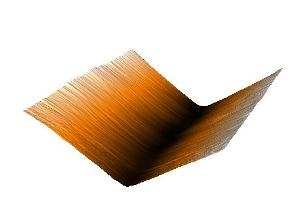Jun 27 2018
Scientists at Brown University have found out another unique and potentially beneficial property of graphene. The findings could be used in guiding nanoscale self-assembly and the analysis of DNA or other biomolecules.
 Stacks of graphene tend to form saw-tooth crinkles when compressed. Those crinkles have an electrical charge that could be useful in studying DNA or guiding nanoscale self-assembly. Image credit: Kim Lab/Brown University.
Stacks of graphene tend to form saw-tooth crinkles when compressed. Those crinkles have an electrical charge that could be useful in studying DNA or guiding nanoscale self-assembly. Image credit: Kim Lab/Brown University.
A research reported in the Proceedings of the Royal Society A mathematically shows the impact of slight lateral compression (a gentle squeeze from the sides) on stacks of graphene sheets.
The researchers demonstrated that in contrast to forming smooth, gently sloping warps and wrinkles over the surface, layered graphene formed sharp, saw-tooth kinks with intriguing electrical properties.
According to Kim, the charge is produced as a result of the quantum behavior of electrons located around the carbon atoms in the graphene lattice. Upon bending the atomic layer, the electron cloud gets concentrated above or below the plane of the layer.
Such a concentration of electrons results in localization of the bending into a sharp point, subsequently producing a line of electrical charge with a width of approximately 1 nm and with the length of the crinkle. Over the tip of an upraised ridge, the charge is negative, and along the bottom of a valley, it is positive.
We call these quantum flexoelectric crinkles. What’s interesting about them is that each crinkle produces a remarkably thin line of intense electrical charge across the surface, which we think could be useful in a variety of applications.”
Kyung-Suk Kim, Senior Author
According to Kim and his team, the electrical charge could be absolutely useful. For instance, it can be used to direct nanoscale self-assembly. Particles with an opposite charge are attracted by the charged crinkles, leading to their assembly along the crinkle valleys or ridges.
Kim stated that the assembly of particles along the crinkles was observed even in earlier experiments; however, at the time, the observations could not be explained clearly.
In the earlier experiments, graphene sheets and buckyballs (i.e., soccer-ball-shaped molecules made of 60 carbon atoms) were used. Scientists dumped buckyballs onto various types of graphene sheets and observed the manner in which they spread out.
In the majority of the cases, the buckyballs dispersed on a layer of graphene in a random manner similar to marbles dropped on smooth wooden floor.
However, it was observed that on one specific kind of multilayer graphene, called HOPG, the balls spontaneously assembled into straight chains stretching over the surface.
We know that HOPG naturally forms crinkles when it’s produced. What we think is happening is that the line charge created by the crinkles causes the buckyballs, which have an electric dipole near the line charge, to line up.”
Kyung-Suk Kim, Senior Author
Likewise, strange behaviors have been observed in experiments with biomolecules such as RNA and DNA on graphene. At times, the molecules arrange themselves in unique patterns in contrast to randomly flopping out as they are anticipated to do.
Kim and his team consider that it is possible to trace these effects to crinkles as well. A majority of biomolecules have an intrinsic negative electrical charge, which makes them assemble along positively charged crinkle valleys.
Engineer crinkled surfaces could be feasible to take complete advantage of the flexoelectric effect. For instance, Kim visualizes a crinkled surface that renders DNA molecules to be stretched out in straight lines, enabling them to be easily sequenced.
Now that we understand why these molecules line up the way they do, we can think about making graphene surfaces with particular crinkle patterns to manipulate molecules in specific ways."
Kyung-Suk Kim, Senior Author
At Kim’s lab in Brown University, many years of research has gone into nanoscale crinkles, wrinkles, folds, and creases. The researchers have demonstrated that it is feasible to develop these structures in a cautiously controlled manner, reinforcing the probability of developing crinkled graphene customized to a wide range of applications.